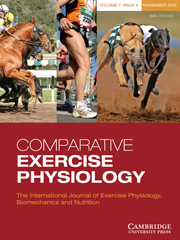Article contents
Regional variation in the flexural properties of the equine hoof wall
Published online by Cambridge University Press: 01 November 2008
Abstract
The equine hoof wall is a hard, keratinous structure that transmits forces generated when the hoof connects the ground to the skeleton of the horse. During locomotion the hoof capsule is known to deform, resulting in an inward curvature of the dorsal wall and expansion of the heels. However, while researchers have studied the tensile and compressive properties, there is a lack of data on the flexural properties of the hoof wall in different locations around the hoof capsule. In this study, the flexural properties and hydration status of the hoof wall were investigated in two orthogonal directions, in different locations around the hoof capsule. The hoof was divided into three regions: the dorsal-most aspect (toe), the medial and lateral regions (quarters) and the heels caudally. Beams were cut both perpendicular (transverse) and parallel (longitudinal) to the orientation of the tubules. Differences in the mechanical properties were then investigated using three-point bending tests. There were considerable differences in the flexural properties around the hoof capsule; transverse beams from the heel were 45% more compliant than those from the toe region. This corresponded with changes in the hydration of the hoof wall; beams from the heel region were more hydrated (28.2 ± 0.60%) than those from the toe (24.2 ± 0.44%; P < 0.01). Regional variation in the water content is thought to help explain differences in the flexural properties. Mechanical data are further discussed in relation to variation in the structure and loading of the hoof wall.
Information
- Type
- Research Paper
- Information
- Copyright
- Copyright © Cambridge University Press 2009
References
- 5
- Cited by

